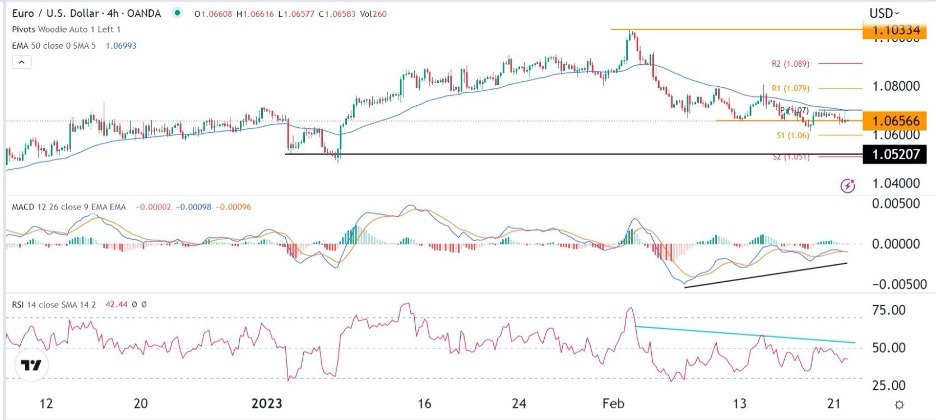Bearish view
- Sell the EUR/USD pair and set a take-profit at 1.0550.
- Add a stop-loss at 1.0750.
- Timeline: 1-2 days.
Bullish view
- Set a buy-stop at 1.0700 and a take-profit at 1.0800.
- Add a stop-loss at 1.0600.
The EUR/USD exchange rate moved sideways for the second day on Tuesday after the strong economic data from Europe and the United States. It remained at the important support level at 1.0660, which was a few points above last Friday’s low of 1.0612.
FOMC minutes ahead
S&P Global published relatively encouraging economic numbers from Europe and the United States on Tuesday. In Europe, flash services PMI numbers rose from 50.8 to 53, signaling that service providers continued their recovery in February. The composite PMI rose from 50.3 to 52.3 even as the manufacturing PMI retreated.
In the US, data showed that the manufacturing PMI rose to 47.8 while the services PMI rose to 50.5. The composite PMI moved to the expansion level of 50.2. Additional data revealed that existing home sales dropped from 4.03 million in January as mortgage rates remained elevated.
There will be several important economic numbers on Wednesday. Germany, Italy, and Spain will publish their final estimate of January’s inflation numbers. While these numbers are important, they will not have a major impact on the pair since they will likely be in line with the first estimate. Germany will publish the latest business sentiment data.
The main thing that will move the EUR/USD pair will be the upcoming minutes by the Federal Reserve. These minutes will provide more information about what to expect in the coming meetings. Historically, they provide more information compared to the single-page document that accompanies the report.
EUR/USD forecast
The EUR/USD pair has been in a strong bearish trend after peaking at 1.1033 on February 3. During this retreat, the pair has moved below the 50-period moving average and the Woodie pivot point. It has also formed a slanting head and shoulders pattern while the current price coincides with the lowest point on February 13.
The MACD has formed a bullish divergence pattern while the Relative Strength Index (RSI) has remained below 50. Therefore, the pair will likely have a bearish breakout, with the next important support being at 1.0520, the lowest point on January 3.
The bearish view will become invalid if the pair manages to move above the Woodie pivot point at 1.0700 will send a signal that there are still more buyers out there. If this happens, the next key point will be the R1 to 1.0800.
Ready to trade our daily Forex signals? Here’s a list of the top Forex brokers worth reviewing.
